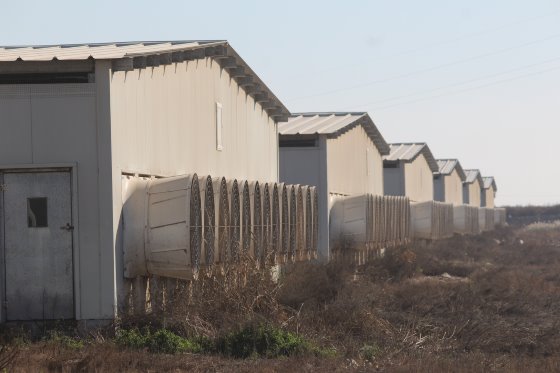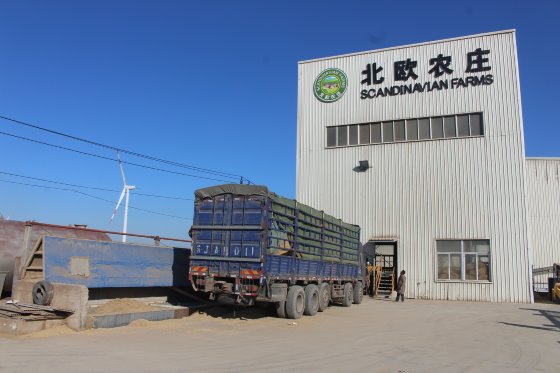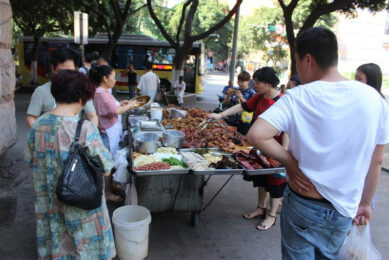Breeding Danish gilts in China
![It looks Danish, but it is in China: gestating sows in group housing with straw racks at their disposal.<br />[Photo: Vincent ter Beek]](https://www.pigprogress.net/app/uploads/2021/04/001_924_rb-image-2777898-848x565.jpeg)
[Photo: Vincent ter Beek]
Several years ago, Danish pig breeding company DanAvl decided it was time to make the jump to China and invested in several Chinese projects. A new breeding farm has been established, just as its own commercial production, and new investments are underway.
“Sometimes Chinese customers tell us that they would rather order breeding gilts directly from Denmark than from our breeding herd here in China. ‘After all it is still China’, they tell me. But it is not! At the Dan Yu Breeding Farm we apply the same regulations and standards as in Denmark.”
This is what Jørgen Lindberg says, CEO of 3 modern Danish pig production initiatives in China, all related in one way or another to DanAvl. One of them is the Dan Yu Breeding Farm, producing gilts – and if ever a place in Asia made you feel like you were in Denmark this must be it. Located in the heart of China, yes, but as far as pigs are concerned, it’s Danish rule that counts. That includes biosecurity, environment, animal welfare, manure management and, of course, a high health status.
Danish production management requires a Danish mindset. For that reason, Lindberg chose to start from scratch to acquire the right staff to run the facilities. He says, “It seems common all over China to hire people who have gone to agricultural university in order to work at a pig farm. I do the opposite. We hire people who previously didn’t know anything about pigs. That way, we can teach them exactly the way we want. Often we give them a specific job, which they can become very specialised in.”
The Danish pig philosophy is visible
Working with a Danish mindset requires a deep understanding of what Denmark’s pig philosophy is, says Lindberg. For instance, working towards high biosecurity doesn’t only mean doing what you are told but understanding and embracing why biosecurity is important.

These are not just words. The Danish influence is visible in virtually every detail at the 1,600-sow Dan Yu Breeding Farm. Just take the location – it is chosen for its high health conditions. The breeding facility with GGP and GP sows is built almost in the East China Sea. About 70% of the time, there’s onshore wind, and within the wide surroundings, there is not even a house to be seen. The direct neighbours are involved in either salines or aquaculture. In fact, the stretch of land is separated from the mainland by a wide canal – and by contract, the Danes are the only ones allowed to have pigs on this semi-island. Last but not least, the farm can only be accessed by a small road; access is only possible through a biosecurity gate.
The location is chosen with a keen eye on the market. The farm is located roughly 20 km away from Liangyungang, Jiangsu province. Being 750 km south of Beijing and 500 km north of Shanghai, the facility can be easily reached by potential customers from both metropolitan areas, who drive as far south or north to pick up their new grandparent or parent stock themselves.
Inside the farm, a lot more of ‘Denmark’ can be found. The air inside the farm is fully filtrated and ventilated – in order to be able to withstand the cold in the winter (temperatures can drop to as low as -9°C) and the heat in the summer (max 43°C). Gestating sows are kept in group housing with free access stalls, they have straw and wooden sticks as distraction materials, and the entire feeding lines – both in the farm as well as in the feed mill have been supplied by Danish feed equipment manufacturer Skiold.

As if all this wasn’t enough: the farm also needs to be running 100% according to Danish regulations in order to keep operating. This is a requirement of the Danish investment fund IFU, which owns 10% of the farm’s shares.
![The young gilts stay at the farm until they reach about 60-70 kg.<br />[Photo: Vincent ter Beek] The young gilts stay at the farm until they reach about 60-70 kg.<br />[Photo: Vincent ter Beek]](/Resizes/420x315/PageFiles/17/30/33017/003/005_289_rb-image-2777903.jpeg)
Project aim: Offer China Danish purebred & crossbred sows
The Danish project started only a few years ago. Parts of the Dan Yu project were constructed by KingPeng, a quality turnkey farm construction company from Beijing. The first gilts arrived at the facility on 17 January 2013. The aim of the RMB 320 million (€44.2 million) project is to be able to offer the Chinese market both high-quality Danish purebred and crossbreed sows, i.e. equipped for high performance as well as large litters.
Lindberg: “I was surprised to see how many people in China actually knew about Danish genetics. Importing pigs from Denmark, however, is relatively expensive due to, for example, the quarantine. That is why it made more sense to have our own farm over here.”
All gilts and sows bought from the farm come with a Danish pedigree. Despite having been born in China, the animals qualify for that because they are all born from Danish sows and inseminated with Danish semen. With ear tagging systems, it is easy to remember which animals qualify as GGP, GP, or to be sold as parent stock, as well as what breed they are.
Lindberg admits that recently, the Chinese market hasn’t been too great for selling breeding animals. Between 2013 and 2015, the Chinese breeding herd decreased by 10 million to roughly 40 million. This is mainly a consequence because of the strong pig cycle being present in China.
Farm set-up
The farm, which can only be entered and exited after having taken a shower, is set up around 14 rooms, identical on either side of an aisle. These include:
- a boar room;
- a gilt room for new GGP sows of the future;
- an insemination room;
- a gestation room with group housing and sick pens;
- a farrowing room;
- a weaner room; the males at this stage move to the nearby Scandinavian Farms, see also box ‘Two more pig operations’
- a grower room where the sows stay until they reach about 60-70 kg; the ideal weight to be selling the animals.
In each section, detailed instructions are available as to how staff need to deal with the animals in each phase of production. This includes for instance mating management, pregnancy control or how to succesfully apply a two-nurse sow strategy – an approach that is useful when working with highly prolific Danish sows.
It goes without saying that using high feed ingredients in the right rations for the right age and life phase is one of the management strategies pursued. The animals receive a dry mixture of corn, barley, wheat, soy and a premix.
A unique feature for Chinese farms is that slurry is collected and separated. The solid fraction is sold as organic fertiliser to local greenhouses growing vegetables. The liquid part is transported away from the farm in pipes, sometimes up to 10 km, and used for grain production. In the area around the pig farm, the fields usually yield two or three crops per year, with wheat in winter and rice in summer.

Uniting the cultures
The importance of high health is even reflected in the reporting structure of the breeding farm, as well as in its neighbouring farms. One member of staff has been appointed as an environmental officer. Twice a week, she visits all the Danish farms and observes whether all procedures are going as intended, and will also see that waste is disposed of properly. Similarly, the main veterinarian is in charge of the guards – this way, he can be absolutely sure that nothing and nobody enters the farm that should not enter.
Of course, Lindberg knows that a farm in China with only a few Danish managers and predominantly Chinese staff will never become fully Danish. He says, “We try not to superimpose our thoughts and guidelines just like that; we try to respect the Chinese culture as well.” Flexibility where possible and strictness where necessary therefore go hand in hand, he explains. “Every day we provide 3 good meals for all farm staff. This is appreciated. We also do it for a reason, as we don’t want our farm workers to leave the grounds and buy food themselves.”
Biosecurity and people management also surface in working times. All farm staff live and work 3 full weeks on the farm – in houses which are heated by energy generated from pig manure. In the 4th week, they enjoy a full week off. This prevents frequent contact every weekend with the outside world and, at the same time, allows farm workers to really spend quality time with their loved ones somewhere else in the country.
In conventional Chinese working weeks, they’d be able to see their children or spouses one day per weekend. Lindberg adds: “People tell me, ‘Now we can really witness our children growing up!’”
Two more pig operations
Apart from the Dan Yu Pig Breeding Farm, Jørgen Lindberg is also CEO of 2 more Danish projects, the most notable being Scandinavian Farms, located a few km away from the breeding farm. It is a large 5,000-sow commercial farrow-to-finish complex comprising 31 pig houses with a total of 35,000 finishing places, which sells its high-quality pigs directly to 3 local slaughterhouses. Apart from the size, the set-up on the farm is identical to the Dan Yu Breeding Farm. The operation has been very successful – achieving almost 31 piglets/sow/year in 2015, leading to estimated sales of 150,000 finisher pigs in 2016.

In the near future, Scandinavian Farms hopes to increase this to 360,000 in 2017 and, within 3 years, to 550,000 finishers. This should all happen because of the addition of a new greenfield facility for an additional 7,700 sows and a further 58,000 finisher places. Construction is expected to start in 2016. At this farm, gestating sows will be kept in groups using Nedap Electronic Sow Feeding (ESF) systems.
The farrow-to-finish complex also comes with a feed mill, with a current capacity of 60,000 tonnes/year. By the end of 2016, this will be 133,000 tonnes/year. The feed mill provides ground dry feed in 8 different rations for both the commercial pig farm as well as the sow farm: 2 for sows, 4 for weaners and 2 for finishers. The feed, usually based on wheat, corn, barley and soymeal is supplemented with additional proteins (Hamlet Protein); premixes (Nuscience) as well as mycotoxin binders (Biomin). It is transported in bulk trucks from one site to the other.

A few km outside the farm complexes, the Danish companies rent an enormous hangar. It is used for storage of wheat and barley, for example, whenever market opportunities arise to buy affordable stocks. The hangar is also used for cleaning feed or pig trucks. For maintenance and surveillance purposes, a couple is happily living in a dwelling inside the hangar.
The third company Lindberg chairs is Dan Yu Trading – a trading company effectively located in Shanghai, which allows Chinese pig farm owners to buy sows directly from Denmark. This process involves a quarantine procedure and is, therefore, relatively costly.











